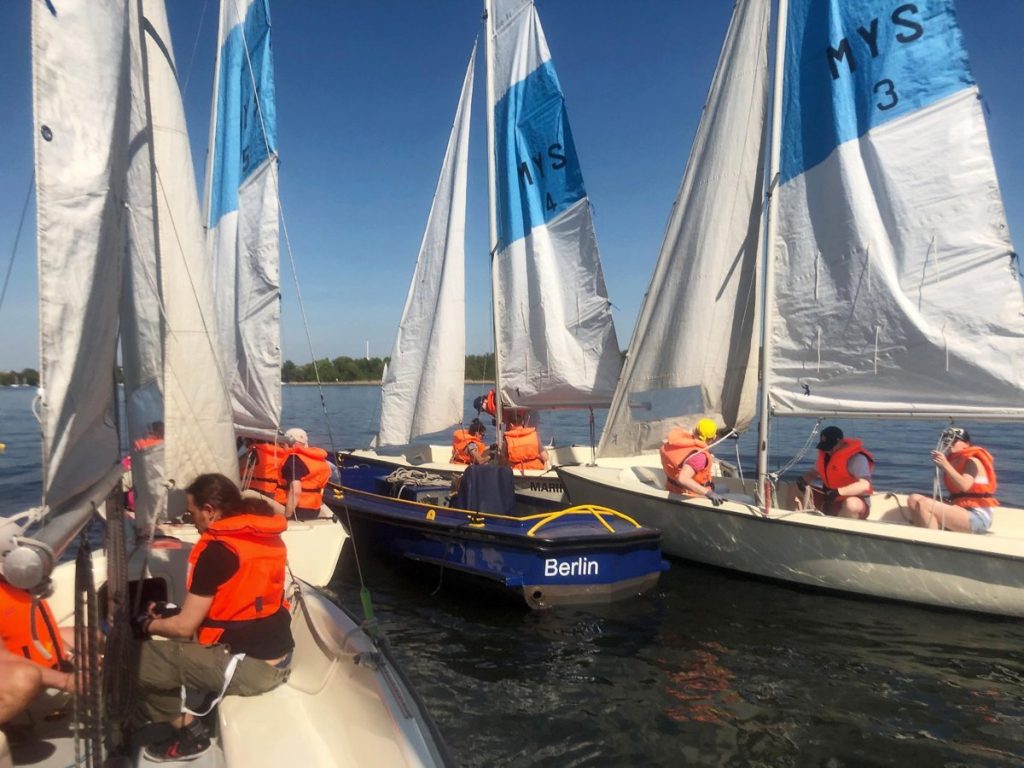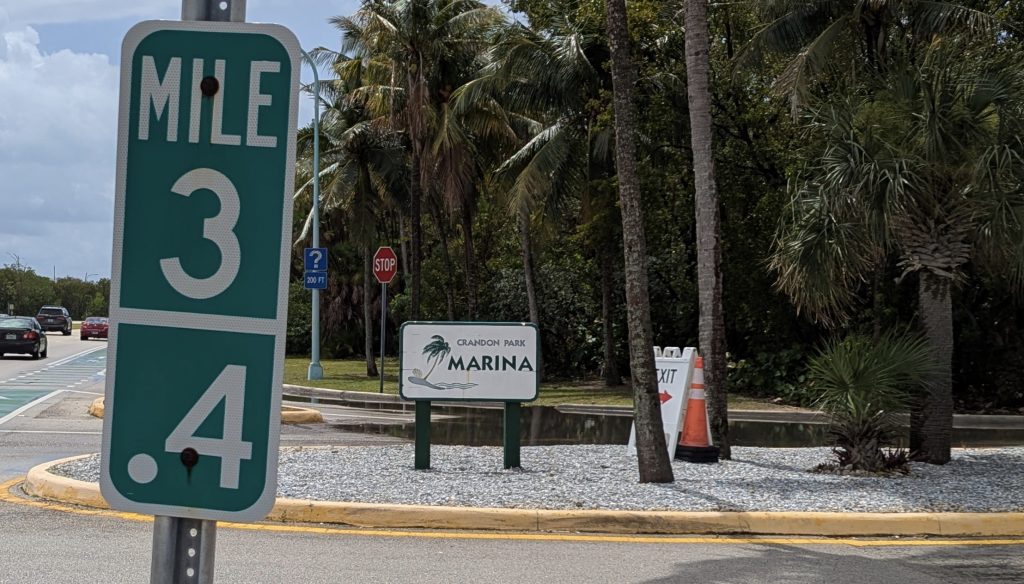Disclosure: Some links in this post are affiliate links. If you click and buy, I may earn a small commission at no extra cost to you. I only recommend items I use myself.
I’ve been boating in both Germany and Florida for many years. I hold international licenses to operate vessels up to 50 feet under sail or power, in both inland and offshore waters. I also taught sailing in Berlin, Germany, where the photo below was taken. My wife is a certified SCUBA instructor here in South Florida, and together we’ve spent countless hours on and in the water—from Boynton Beach to the Lower Keys. The ocean has always been our playground, whether it’s under sail, powerboating, or beneath the surface.

Teaching beginner sailors during a lesson in Berlin, Germany. I spent years as a sailing instructor before moving to Florida.
Why Miami Boat Ramps for Beginners Can Be Intimidating
You might be hesitant to launch if you’ve ever watched any of the “boat ramp fail” videos on YouTube—especially from Miami boat ramps. Let’s just say they edit together the most chaotic, stressful moments to get clicks. But there’s some truth to the intimidation. Here’s why:
- Tides & Currents: While the sea level only rises and falls about 1–3 feet, the current can make docking and launching more difficult and affect fuel use and your enjoyment out on the water. Check out the video of Haulover Inlet below to get an idea of how wind and currents can team up against a boater.
- Ramp Differences: Each ramp has unique traffic flow, signage, dock layout, and staff practices. There are unwritten rules and different enforcement approaches everywhere.
- Slippery Ramps & Vehicle Risks: You’ve probably seen cars sliding into the water. The algae that forms on infrequently cleaned ramps can be slicker than ice. The bigger threat however is from the water on your trailer and back tires. The Salt water in South Florida is especially corrosive.
- King Tides: You may have to back your vehicle deeper into the water to float the boat, especially if it’s a shallow-hull design. This can put your not only your back tires, but also your brakes underwater.
- Algal Blooms: Red tide and other blooms are serious. If you see brown/red-green water and dead fish, steer clear. Breathing the fumes or skin exposure can cause real health issues.
- The other boaters: Heat, humidity, and stress do not mix well. Add the “me first” mentaliy of many people here in Miami and it can get crazy.
Boat launching from Miami boat ramps can be stressful, especially for beginners. It kept us from buying a boat here for years. Miami Boat Ramps for Beginners was not available!
Don’t create more content for this guy, prepare and know the conditions befor you go out.
Key Tips for Smooth Launches
1. Prepare Before You Even Pick Up the Boat
Scout your ramp. Drive there without the trailer and look around. Note which lanes you’ll need and where to prep and park.
Helpful links:
- Ramp operational status
- Sign up for Marina alerts – Miami Boat Ramps for Beginners, extra tip
- Marina Fees and tips to secure your boat for a hurricane
2. Know the Ramp Hours
Some ramps like Crandon, Pelican Harbor, and Blackpoint are open 24/7. Others have limited ramp hours, but offer gate-controlled after closing exits. Confirm ahead—websites can be outdated. When in doubt, call.
3. Show Up at the Right Time
Avoid 6 a.m. pro-fisher crowds, but don’t show up too late either. Between 7–8 a.m. is the sweet spot. I’ve received notices by 8:07 a.m. that Crandon is full. If you go during the sweet spot you will have less stress and fewer people and boats to avoid.
4. Use the Staging Area
Transfer your gear before reaching the ramp. Even if it means circling through the parking lot, take the time to prep in the designated setup lane. Dont be “that guy”.
5. Don’t Block the Ramp
Once your boat is launched, let your helpers move the boat to the end of the dock. You can focus on getting your vehicle to a parking spot. That way, the next person can already launch their boat while you are getting ready to leave.
6. Learn From Others
Observe experienced boaters and pay attention to etiquette. You’ll fit in faster and reduce your stress level.
7. Nervous About Your Car?
Consider renting a truck. U-Haul’s $20/day pickups are popular at the ramps: U-Haul Rentals
U-Haul truck at a boat ramp—real-world example of a beginner boater.
8. Dry Slips & Storage Alternatives
Some friends of ours keep their boats in dry slips—they call ahead and their boat’s in the water when you arrive. Expect around $800/month to dry slip a 30 foot boat; trailer storage extra. Renting a storage spot, for your boat on the trailer, but you have to take it to the ramp will cost around $13–$15/foot monthly. The best time to look for a spot to store your boat is ahead of boating season in May.
Avoiding Common Mistakes
Don’t back up under pressure:
- Place your hands at the 6 o’clock position on the wheel.
- Move your hands right = trailer goes right. Left = trailer left.
- Go slow. Breathe. Everyone had to learn.
Loading or unloading your boat stuff at the ramp:
- Don’t do it.
Forgetting to pay or get a permit:
- Some ramps require proof of payment before entry.
- Have the pay-by-phone app ready with the correct location number.
- Pay when required, but before exiting your vehicle in the parking lot.
Salt damage prevention:
- Wash the trailer and car undercarriage thoroughly—especially after King tide launches.
- Take extra time to wash the axels and brakes with fresh water
- Consider using this rust inhibitor
And don’t forget the boat plug… buy a spare
Avoid Algal Blooms
If you see discolored water or dead fish, steer clear. Blooms are harmful to humans and pets.
- Wash off skin/fur/clothing after contact.
- Don’t let pets lick themselves.
- Stay updated via weather apps or alerts.
Best Miami Boat Ramps for Beginners
Looking for the most beginner-friendly ramp in Miami? I have tried most, researched all, and spoken with friends and the local authorities about every Miami-Dade boat ramp. I’ve picked my favorite Miami boat ramps for beginners – Read my full Crandon Marina review here

Recommended Gear & Apps
Essentials:
- Rust Inhibitor Spray – save your trailer and vehicle from the harsh saltwater.
- Battery Jump Starter – possibly save the boat day and avoid calling seatow.
- Soft Wood Plugs – don’t leave the dock without an emergency plan.
- Spare Drain Plug – Everyone should carry one of these.
- Floating Boat Hook – totally essential and used ALL the time.
Safety:
These are the products I have on my boat and am very satisfied with the value. Make sure to check your local safety requirements.
- Fenders
- Dock Lines
- Floatation Cushion
- First Aid Kit
- SOS LED Distress Light
- Lifesaving Rope
- Fire Extinguisher
- USCG Life Jacket
Apps:
- Windy.app – For tides, wind, and swell conditions
- BoatUS membership – For help on the water
- Garmin boat navigation – There are many obstacles and shallows in South Florida waters
Conclusion
Boat ramps for beginners in South Florida can be intimidating—but with the right mindset, preparation, and tools, you’ll launch like a local.
Make time to scout your ramp. Talk to other boaters. Learn the local rhythm. Once you’ve got the hang of it, the rewards are huge. There’s no better place to spend a weekend than on the water in Miami.
The South Florida waters have so much to offer, but that’s a story for another post.
And that was: Miami Boat Ramps for Beginners!
